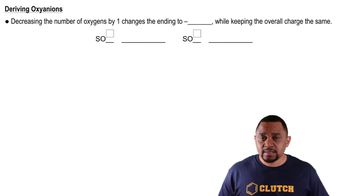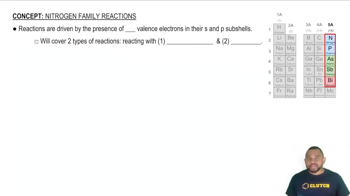Ch.22 - Chemistry of the Nonmetals
Chapter 22, Problem 85
Complete the exercises below. a. What is the oxidation state of P in PO₄³⁻ and N in NO₃⁻? b. Why doesn't N form a stable NO₄³⁻ ion analogous to P?
 Verified step by step guidance
Verified step by step guidance1
Step 1: Understand the concept of oxidation states. The oxidation state (or oxidation number) of an atom in a compound is a measure of the degree of oxidation of an atom. It is defined as the charge an atom would have if the compound was composed of ions.
Step 2: Determine the oxidation state of P in PO₄³⁻. Start by knowing that the sum of oxidation states in a polyatomic ion equals the charge of the ion. Oxygen typically has an oxidation state of -2. Set up the equation: x + 4(-2) = -3, where x is the oxidation state of P.
Step 3: Solve for the oxidation state of P. Rearrange the equation from Step 2 to find the value of x, which represents the oxidation state of phosphorus in the phosphate ion.
Step 4: Determine the oxidation state of N in NO₃⁻. Similarly, for the nitrate ion, set up the equation: y + 3(-2) = -1, where y is the oxidation state of N.
Step 5: Explain why N doesn't form a stable NO₄³⁻ ion. Consider the electronic configuration and the ability of nitrogen to expand its octet. Unlike phosphorus, nitrogen lacks available d-orbitals to accommodate more than 8 electrons, making NO₄³⁻ unstable.
Key Concepts
Here are the essential concepts you must grasp in order to answer the question correctly.
Oxidation State
The oxidation state, or oxidation number, is a measure of the degree of oxidation of an atom in a chemical compound. It indicates the number of electrons that an atom can gain, lose, or share when forming chemical bonds. In polyatomic ions like PO₄³⁻ and NO₃⁻, the oxidation state helps determine the charge distribution and the overall stability of the ion.
Recommended video:
Guided course

Oxidation Numbers
Polyatomic Ions
Polyatomic ions are ions composed of two or more atoms covalently bonded together, which carry a net charge due to the loss or gain of electrons. Understanding the structure and charge of polyatomic ions like PO₄³⁻ and NO₃⁻ is essential for determining the oxidation states of their constituent elements and predicting their chemical behavior.
Recommended video:
Guided course

Polyatomic Ion Variations
Nitrogen's Valence and Stability
Nitrogen has a valence of three, allowing it to form stable compounds with three bonds. The formation of a hypothetical NO₄³⁻ ion would require nitrogen to exceed its typical bonding capacity, leading to instability. In contrast, phosphorus can expand its valence shell to accommodate more than four bonds, allowing for the stable formation of PO₄³⁻.
Recommended video:
Guided course

Nitrogen Family Reactions
Related Practice
